How Can I Read a Usb Memory Stick With My Z180 Microcontroller
Flash memory, also known as wink storage, is a type of nonvolatile retention that erases information in units chosen blocks and rewrites data at the byte level. Flash memory is widely used for storage and information transfer in consumer devices, enterprise systems and industrial applications. Wink memory retains data for an extended flow of time, regardless of whether a flash-equipped device is powered on or off.
Flash retentivity is used in enterprise data center server, storage and networking technology, every bit well as in a wide range of consumer devices, including USB flash drives -- also known as retentiveness sticks -- SD cards, mobile phones, digital cameras, tablet computers and PC cards in notebook computers and embedded controllers. For instance, NAND flash-based solid-state drives are frequently used to accelerate the performance of I/O-intensive applications. NOR wink memory is often used to concur control code, such as the basic input/output system (BIOS), in a PC.
Flash retentiveness is also used for in-retention calculating to help speed performance and scalability of systems that manage and analyze large sets of information.
Origins of wink storage technologies
Dr. Fujio Masuoka is credited with the invention of wink memory when he worked for Toshiba in the 1980s. Masuoka's colleague, Shoji Ariizumi, reportedly coined the term wink because the process of erasing all the data from a semiconductor chip reminded him of the wink of a camera.
Flash retentivity evolved from erasable programmable read-just retentivity (EPROM) and electrically erasable programmable read-only memory (EEPROM). Flash is technically a variant of EEPROM, but the industry reserves the term EEPROM for byte-level erasable retention and applies the term wink memory to larger block-level erasable memory.
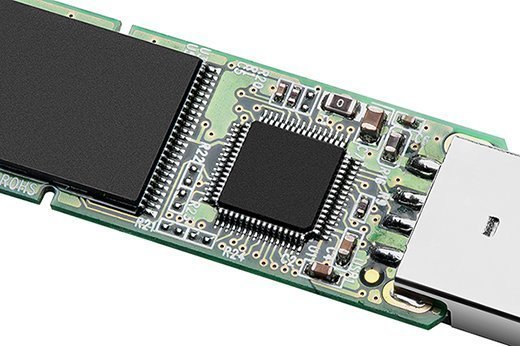
How does flash memory work?
Wink retentivity compages includes a retention array stacked with a large number of flash cells. A basic flash retentivity cell consists of a storage transistor with a command gate and a floating gate, which is insulated from the balance of the transistor past a thin dielectric cloth or oxide layer. The floating gate stores the electrical charge and controls the flow of the electric electric current.
electrons are added to or removed from the floating gate to alter the storage transistor'due south threshold voltage. Changing the voltage affects whether a cell is programmed equally a zip or a one.
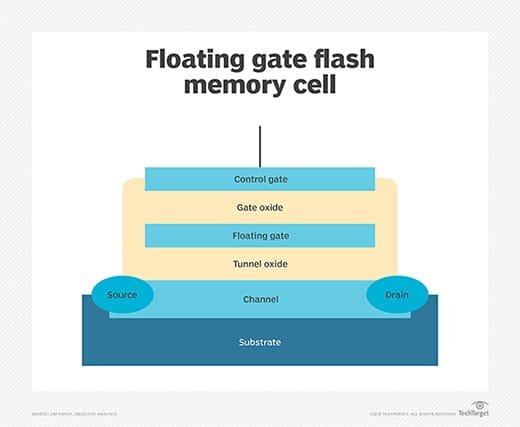
A procedure called Fowler-Nordheim tunneling removes electrons from the floating gate. Either Fowler-Nordheim tunneling or a miracle known as channel hot-electron injection traps the electrons in the floating gate.
With Fowler-Nordheim tunneling, information is erased via a potent negative charge on the control gate. This forces electrons into the aqueduct, where a potent positive charge exists.
The reverse happens when using Fowler-Nordheim tunneling to trap electrons in the floating gate. Electrons manage to forge through the thin oxide layer to the floating gate in the presence of a high electrical field, with a strong negative charge on the prison cell'due south source and the drain and a stiff positive accuse on the command gate.
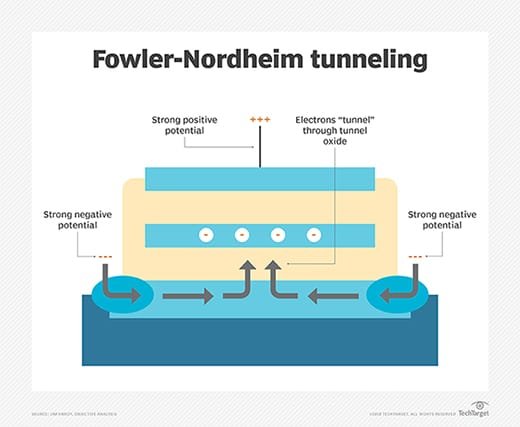
Channel hot-electron injection, also known as hot-carrier injection, enables electrons to suspension through the gate oxide and change the threshold voltage of the floating gate. This quantum occurs when electrons acquire a sufficient amount of energy from the loftier current in the channel and the attracting charge on the control gate.
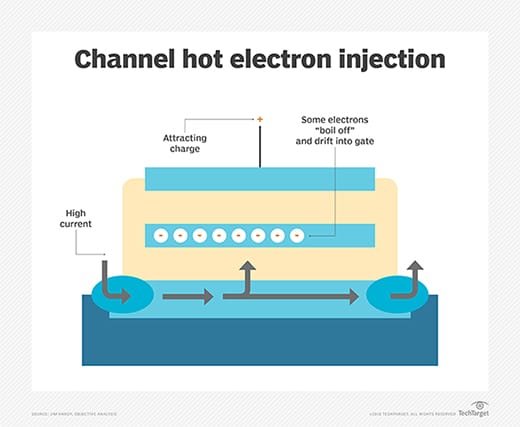
Electrons are trapped in the floating gate whether or not a device containing the wink retention cell is receiving power as a result of electrical isolation created by the oxide layer. This characteristic enables flash memory to provide persistent storage.
NOR vs. NAND flash retentivity
There are two types of flash memory: NOR and NAND.
NOR and NAND wink memory differ in architecture and design characteristics. NOR wink uses no shared components and can connect private memory cells in parallel, enabling random access to information. A NAND wink cell is more compact and has fewer bit lines, stringing together floating gate transistors to increase storage density.
NAND is improve suited to series rather than random data access. NAND flash process geometries were developed in response to planar NAND reaching its practical scaling limit.
NOR flash is fast on data reads, but it is typically slower than NAND on erases and writes. NOR flash programs information at the byte level. NAND flash programs data in pages, which are larger than bytes, simply smaller than blocks. For example, a page might be 4 kilobytes (KB), while a block might be 128 KB to 256 KB or megabytes in size. NAND wink consumes less power than NOR flash for write-intensive applications.
NOR flash is more expensive to produce than NAND wink and tends to exist used primarily in consumer and embedded devices for boot purposes and read-only applications for code storage. NAND flash is more suitable for data storage in consumer devices and enterprise server and storage systems due to its lower cost per flake to store data, greater density and higher programming and erase (P/Due east) speeds.
Devices, such as camera phones, may employ both NOR and NAND flash, in addition to other retentivity technologies, to facilitate lawmaking execution and data storage.
Wink memory grade factors
Wink-based media is based on a silicon substrate. Besides known as solid-state devices, they are widely used in both consumer electronics and enterprise data storage systems.
There are three SSD form factors that accept been identified by the Solid Land Storage Initiative:
- SSDs that fit into the aforementioned slots used by traditional electromechanical hard disk drives (HDDs). SSDs have compages similar to that of an integrated circuit.
- Solid-state cards that reside on a printed excursion board and use a standard carte course factor, such as Peripheral Component Interconnect Express (PCIe).
- Solid-land modules that fit in a dual inline retentiveness module (DIMM) or pocket-size outline dual inline memory module using a standard HDD interface, such as the Serial Avant-garde Technology Attachment (SATA).
An additional subcategory is a hybrid hard drive that combines a conventional HDD with a NAND wink module. A hybrid difficult drive is generally viewed as a way to bridge the divide between rotating media and flash memory.
All-flash and hybrid wink memory
The appearance of flash retention fueled the rise of all-flash arrays. These systems contain only SSDs, they offering advantages in functioning and potentially reduced operational costs, compared to all disk-based storage arrays. The chief difference, aside from the media, is in the underlying physical architecture used to write data to a storage device.
HDD-based arrays take an actuator arm that enables data to be written to a specific block on a specific sector on the disk. All-wink storage systems do non crave moving parts to write information. The writes are made directly to the flash retention and custom software handles data management.
A hybrid flash assortment blends deejay and SSDs. Hybrid arrays use SSDs every bit a enshroud to speed admission to ofttimes requested hot information, which after is rewritten to dorsum-end disk. Many enterprises usually archive information from disk as it ages past replicating information technology to an external magnetic tape library.
Flash plus record, also known equally flape, describes a type of tiered storage in which chief information in flash is simultaneously written to a linear tape organization.
In add-on to flash memory arrays, the ability to insert SSDs in x86-based servers has increased the technology's popularity. This arrangement is known as server-side flash memory and it enables companies to sidestep the vendor lock-in associated with purchasing expensive and integrated flash storage arrays.
The drawback of placing wink in a server is that customers need to build the hardware system internally, including the purchase and installation of a storage management software stack from a third-party vendor.
Pros and cons of flash retentiveness
Hither are some advantages of flash memory:
- Wink is the least expensive form of semiconductor memory.
- Unlike dynamic random access memory (DRAM) and static RAM (SRAM), wink memory is non-volatile, offers lower ability consumption and can be erased in big blocks.
- NOR flash offers increased random read speeds, while NAND flash is fast with series reads and writes.
- An SSD with NAND flash memory fries deliver significantly college functioning than traditional magnetic storage media, such every bit HDDs and record.
- Flash drives also consume less power and produce less heat than HDDs.
- Enterprise storage systems equipped with flash drives are capable of low latency, which is measured in microseconds or milliseconds.
The master disadvantages of flash retentivity are the wear-out mechanism and jail cell-to-cell interference as the dies go smaller. Bits can fail with excessively loftier numbers of program/erase cycles, which eventually break down the oxide layer that traps electrons. The deterioration can distort the manufacturer-set threshold value at which a charge is adamant to be a zero or a i. Electrons may escape and become stuck in the oxide insulation layer, leading to errors and bit rot.
Anecdotal testify suggests NAND wink drives are not wearing out to the caste one time feared. Flash drive manufacturers accept improved endurance and reliability through mistake correction lawmaking algorithms, wear leveling and other technologies.
In addition, SSDs do not wear out without warning. They typically warning users in the same manner a sensor might point an underinflated tire.
NAND flash memory storage types
NAND wink semiconductor manufacturers accept developed different types of retention suitable for a wide range of data storage uses cases. The following nautical chart explains the diverse NAND wink types.
| Types of NAND flash retention storage | ||||
| Description | Advantages | Disadvantages | Master use | |
| Unmarried-level prison cell ( SLC ) | Stores one bit per cell and two levels of charge. | Higher functioning, endurance and reliability than other types of NAND flash. | Higher cost than other types of NAND flash. | Enterprise storage, mission-critical applications. |
| Multi-level cell ( MLC ) | Can shop multiple $.25 per cell and multiple levels of charge. The term MLC equates to two bits per jail cell. | Cheaper than SLC and enterprise MLC (eMLC), loftier density. | Lower endurance than SLC and eMLC, slower than SLC. | Consumer devices, enterprise storage. |
| Enterprise MLC ( eMLC ) | Typically stores two bits per cell and multiple levels of charge; uses special algorithms to extend write endurance. | Less expensive than SLC wink, greater endurance than MLC flash. | More expensive than MLC, slower than SLC. | Enterprise applications with loftier write workloads. |
| Triple-level cell ( TLC ) | Stores three $.25 per cell and multiple levels of charge. Also referred to as MLC-iii, X3 or 3-bit MLC. | Lower cost and higher density than MLC and SLC. | Lower performance and endurance than MLC and SLC. | Mass storage consumer applications, such as USB drives and flash retentiveness cards. |
| Vertical/ 3D NAND | Stacks retentivity cells on meridian of each other in three dimensions vs. traditional planar NAND technology. | Higher density, higher write functioning and lower cost per bit vs. planar NAND. | College manufacturing cost than planar NAND; difficulty in manufacturing using production planar NAND processes; potentially lower information retention. | Consumer and enterprise storage. |
| *Quad-level cell (QLC) | Uses a 64-layer compages that is considered the adjacent iteration of 3D NAND. Not widely available as of November 2017. | Stores four $.25 of data per NAND cell, potentially boosting SSD densities. | More data $.25 per cell can affect endurance; increased costs of engineering. | Mostly write in one case, read many (WORM) utilise cases. |
| Note: NAND flash habiliment-out is less of a trouble in SLC flash than information technology is in less expensive types of flash, such every bit MLC and TLC, for which the manufacturers may set up multiple threshold values for a charge. | ||||
This video covers some of the basics of 3D NAND equally information technology relates to NAND:
NOR flash memory types
The 2 main types of NOR wink memory are parallel and serial, too known as series peripheral interface. NOR wink was originally available only with a parallel interface. Parallel NOR offers high performance, security and additional features; its principal uses include industrial, automotive, networking and telecom systems and equipment.
NOR cells are connected in parallel for random admission. The configuration is geared for random reads associated with microprocessor instructions and to execute codes used in portable electronic devices, nigh exclusively of the consumer variety.
Serial NOR flash has a lower pin count and smaller packaging, making information technology less expensive than parallel NOR. Use cases for serial NOR include personal and ultra-thin computers, servers, HDDs, printers, digital cameras, modems and routers.
Vendor breakdown of enterprise NAND flash memory products
Major manufacturers of NAND flash memory chips include Intel Corp., Micron Technology Inc., Samsung Group, SanDisk Corp. -- at present endemic by Western Digital Corp. -- SK Hynix Inc. and Toshiba Memory Corp.
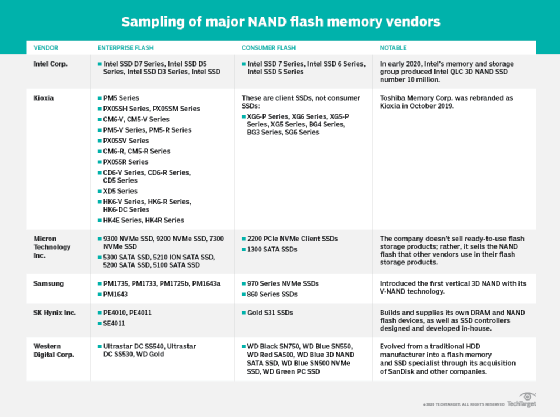
There was a NAND flash shortage in 2016 causing a disruption in the market. The shortfall caused SSD prices to rise and atomic number 82 times to lengthen. The demand outstripped supply largely due to soaring demand from smartphone makers. In 2018, signs began showing that the shortage was near its finish.
Other turmoil is exerting an touch on the market. In November 2017, leading wink supplier Toshiba agreed to sell its chip making unit of measurement to a group of corporate and institutional investors led by Bain Capital letter. Toshiba sold the wink business organization as office of its effort to embrace fiscal losses and to avert beingness delisted on the Tokyo Stock Substitution.
Leading NOR vendor products
Major manufacturers of NOR flash retentiveness include Cypress Semiconductor Corp. -- through its acquisition of Spansion Inc. -- Macronix International Co. Ltd., Microchip Technology Inc., Micron Technology Inc. and Winbond Electronics Corp.
Cypress Semiconductor acquired NOR flash provider Spansion in 2015. The Cypress NOR portfolio includes FL-Fifty, FL-S, FS-Southward and FL1-K products.
Macronix OctaFlash uses multiple banks to enable write admission to 1 banking concern and read from another. Macronix MX25R Series NOR is a low-ability version that targets internet of things (IoT) applications.
Microchip NOR is branded every bit Series SPI Flash and Serial Quad I/O Flash. The vendor's parallel NOR products include the Multi-Purpose Wink devices and Advanced Multi-Purpose Wink devices families.
Micron sells Serial NOR Flash and Parallel NOR Flash, also as Micron Xccela high-performance NOR flash for automotive and IoT applications.
The Winbond serial NOR product line is branded as SpiFlash Memories and includes the W25X and W25Q SpiFlash Multi-I/O Memories. In 2017, Winbond expanded its line of Secure Wink NOR for additional uses, including system-on-a-chip design to support artificial intelligence, IoT and mobile applications.
reardonfichames1940.blogspot.com
Source: https://www.techtarget.com/searchstorage/definition/flash-memory
Post a Comment for "How Can I Read a Usb Memory Stick With My Z180 Microcontroller"